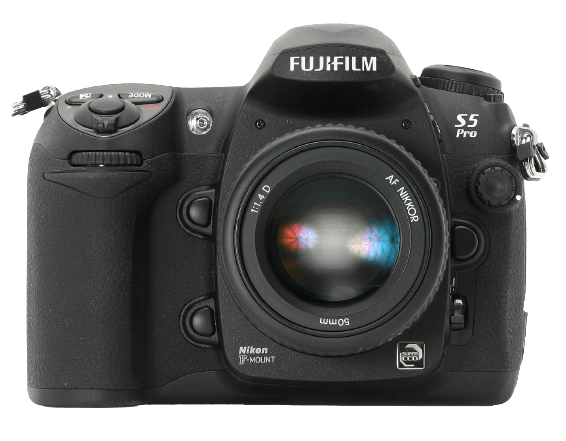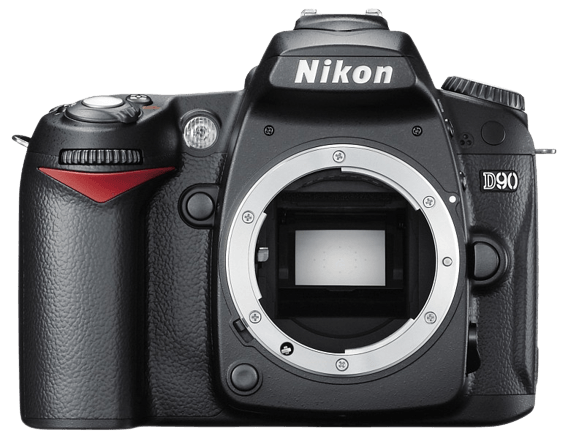Fujifilm FinePix S5 Pro vs Nikon D90 Comparison
Fujifilm FinePix S5 Pro

Nikon D90

The Nikon D90 emerges as the winner with a score of 44/100, while the Fujifilm FinePix S5 Pro scores 36/100. Both cameras are DSLRs, announced in 2008 and 2006 respectively, with similar launch prices of $1235 and $1200.
The winning Nikon D90 has a smaller and lighter body, measuring 132 x 103 x 77mm and weighing 703g. This makes it more portable and convenient for photographers. The Fujifilm FinePix S5 Pro, on the other hand, is larger and heavier at 147 x 113 x 74mm and 920g. This may be a disadvantage for some users, but it could imply a more robust build.
Considering the scores and specifications, the Nikon D90 is a better choice for those prioritizing portability, while the Fujifilm FinePix S5 Pro may cater to those seeking a sturdier camera.
Fujifilm FinePix S5 Pro vs Nikon D90 Overview and Optics
The Nikon D90 outperforms the Fujifilm FinePix S5 Pro in optics, scoring 46/100 compared to the S5 Pro’s 43/100. Both cameras share several common specifications, such as an APS-C sensor size, Nikon F DX lens mount, and the absence of image stabilization. However, there are key differences that contribute to the Nikon D90’s higher score.
The Nikon D90 has a higher megapixel count at 12.3, compared to the S5 Pro’s 6.1 megapixels. This difference allows the D90 to capture more detail and produce higher resolution images. Additionally, the Nikon D90 features a CMOS sensor and an Expeed processor, which contribute to its DXOMARK sensor score of 73. This score indicates better overall image quality and performance compared to the S5 Pro, which lacks a DXOMARK score.
On the other hand, the Fujifilm FinePix S5 Pro has a faster shooting speed of 5.5 frames per second, compared to the Nikon D90’s 4.5 frames per second. This advantage allows the S5 Pro to capture fast-moving subjects more effectively. The S5 Pro also features a Super CCD sensor and Real Photo Processor Pro, which provide unique image rendering and color reproduction.
Taking these factors into account, the Nikon D90 is superior to the Fujifilm FinePix S5 Pro in terms of optics, mainly due to its higher megapixel count and better sensor performance. However, the S5 Pro’s faster shooting speed may be an advantage for specific photography needs. Ultimately, the choice between these two cameras will depend on individual preferences and photography requirements.
Fujifilm FinePix S5 Pro vs Nikon D90 Video Performance
When comparing the Fujifilm FinePix S5 Pro and the Nikon D90, it is important to mention that neither of these cameras have video capabilities. Therefore, there is no video score for either camera, as they both lack this feature.
Fujifilm FinePix S5 Pro vs Nikon D90 Features and Benefits
The Nikon D90 outperforms the Fujifilm FinePix S5 Pro in terms of features, scoring 41/100 compared to the S5 Pro’s 17/100. Both cameras share some common specifications, such as the absence of a touchscreen, flip screen, GPS, WIFI, and Bluetooth. Despite these similarities, there are key differences that make the Nikon D90 a more attractive choice.
The D90’s screen size is larger, measuring 3 inches compared to the S5 Pro’s 2.5 inches. This difference allows for a more comfortable and enjoyable viewing experience. Additionally, the D90 boasts a significantly higher screen resolution of 920,000 dots, while the S5 Pro only has 230,000 dots. This higher resolution results in crisper and clearer images on the D90’s screen.
Although the Fujifilm FinePix S5 Pro falls short in these areas, it is important to remember that features are not the only aspect to consider when choosing a camera. Factors such as image quality, ease of use, and overall performance should also be taken into account.
Taking the differences in features into consideration, the Nikon D90 emerges as the better option due to its larger screen size and higher screen resolution. However, potential buyers should weigh these advantages against their personal preferences and photography needs. Ultimately, the best camera for one individual may not be the best for another, making it crucial to evaluate all aspects of a camera before making a decision.
Fujifilm FinePix S5 Pro vs Nikon D90 Storage and Battery
The Fujifilm FinePix S5 Pro outperforms the Nikon D90 in storage and battery with a score of 51/100, while the Nikon D90 scores 37/100. Both cameras have one memory card slot, and neither supports USB charging. The Fujifilm FinePix S5 Pro accepts Compact Flash (Type I or II) memory cards, while the Nikon D90 is compatible with SD/SDHC cards.
The Fujifilm FinePix S5 Pro has a significantly longer battery life, providing 2438 shots per charge, compared to the Nikon D90’s 850 shots. The FinePix S5 Pro uses an NP-150 battery, while the Nikon D90 uses an EN-EL3e battery. This advantage makes the FinePix S5 Pro more suitable for extended photography sessions without the need for frequent battery changes.
The Nikon D90 does not have any clear advantages in storage and battery over the Fujifilm FinePix S5 Pro. Both cameras have similar storage capabilities, but the FinePix S5 Pro’s longer battery life sets it apart as the better choice in this category.
Fujifilm FinePix S5 Pro vs Nikon D90 – Our Verdict
Are you still undecided about which camera is right for you? Have a look at these popular comparisons that feature the Fujifilm FinePix S5 Pro or the Nikon D90:

